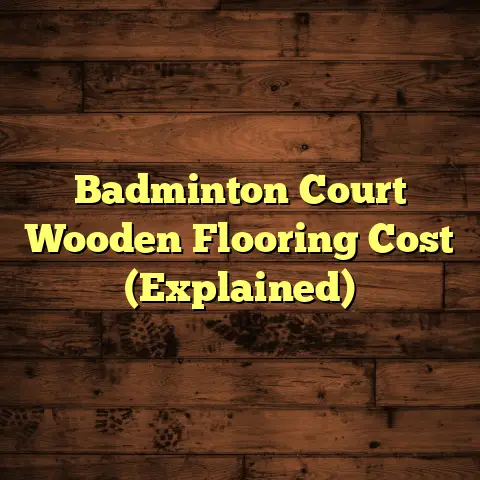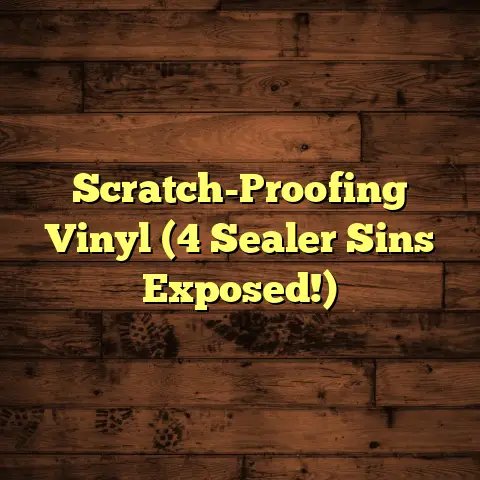Cleaning Floors With Grooves: Easy! (1 Trick)
Grooved flooring is super popular these days.
It adds a touch of modern elegance and
a bit of practicality to our homes, right?
But let’s be real, cleaning those grooves can be a real pain.
Dirt loves to hide in those little crevices, and it feels like no matter what you do, you can’t get them truly clean.
Don’t worry, I’ve been there!
After years of dealing with all kinds of
flooring, I’ve found a simple trick
that can make cleaning grooved floors
a breeze.
Seriously, just one easy step
can totally change your cleaning game.
This article is all about that one trick.
I’ll walk you through everything you need
to know to keep your grooved floors
looking their best, without spending
hours on your hands and knees.
Let’s dive in and get those floors sparkling!
Section 1: Understanding Grooved Flooring
So, what exactly is grooved flooring?
Basically, it’s any type of flooring that has intentional grooves or indentations on its surface.
Think about it:
- Hardwood: Some hardwood floors have
a textured surface with shallow grooves. - Laminate: Laminate can mimic the look
of real wood, including the grooves. - Tile: You might find grooved tiles,
especially in outdoor areas or bathrooms
for added traction.
These grooves aren’t just for looks; they offer some cool benefits.
For example, they provide better traction, which is great for preventing slips and falls.
They also add visual interest to a room, making it feel more dynamic and stylish.
Plus, grooved floors can actually hide dirt
and wear better than perfectly smooth surfaces.
That’s a win, right?
Now, let’s talk materials.
The type of material
your grooved floor is made of will affect
how you clean it.
- Hardwood: Requires gentle cleaning
to avoid water damage. - Laminate: More water-resistant but
can still be damaged by harsh chemicals. - Tile: Typically the most durable and
easiest to clean, but grout lines can
be a challenge.
Knowing your floor’s material is key to choosing the right cleaning method.
Section 2: The Challenges of Cleaning Grooved Floors
Okay, let’s get real about the struggles
of cleaning grooved floors.
The biggest
problem is dirt accumulation.
Those grooves are like tiny magnets for dust, crumbs, and all sorts of grime.
And because they’re recessed, it’s tough to reach them with regular cleaning tools.
Think about it:
A regular mop tends to glide right over the grooves, leaving the dirt untouched.
A standard vacuum cleaner might not have enough suction to pull debris out of the crevices.
And if you’re not careful, you could even damage the floor’s surface while trying to clean it.
I’ve seen homeowners use abrasive scrubbers
that scratch the finish or harsh chemicals
that discolor the floor.
Not good!
Here’s a quick rundown of common cleaning methods that often fall short:
- Mops: Can spread dirty water around
without actually cleaning the grooves. - Vacuums: May not have the right
attachments or suction power. - Steam Cleaners: Can be risky for
certain materials like hardwood and laminate. - Abrasive Cleaners: Can scratch and
damage the floor’s surface.
So, what’s the solution? That’s where my one simple trick comes in.
Section 3: The One Trick for Easy Cleaning
Alright, are you ready for my secret weapon?
It’s so simple, you’ll wonder why you
didn’t think of it sooner:
Use a detailing brush with a specialized cleaning solution.
Yes, that’s it!
Now, before you roll your eyes and say,
“Tony, that’s too simple,” hear me out.
It’s all about the right tools and technique.
Here’s a step-by-step guide to using this trick effectively:
Preparation:
Gather your supplies: You’ll need:
- A detailing brush: I recommend a brush
with firm, but not overly stiff, bristles.
Think something like a car detailing brush
or even a toothbrush for smaller areas.
You can find these at most hardware stores
or online. - A specialized cleaning solution: Choose
a cleaner that’s appropriate for your
floor’s material.
For hardwood, use a
pH-neutral wood floor cleaner.
For laminate,
use a laminate floor cleaner.
For tile,
a mild all-purpose cleaner will usually do the trick.
Pro Tip: Always test the cleaner in
an inconspicuous area first to make
sure it doesn’t damage the floor. - A spray bottle (if your cleaner doesn’t
come in one) - Clean microfiber cloths
- A vacuum cleaner (for pre-cleaning)
- Pre-clean the floor: Before you start
scrubbing, vacuum the floor thoroughly
to remove loose dirt and debris.
This will
prevent you from just pushing the dirt
around with the brush.
- A detailing brush: I recommend a brush
The Cleaning Process:
- Spray the cleaning solution: Lightly
spray the cleaning solution onto a small
section of the grooved floor.
Don’t overdo it;
you don’t want to soak the floor. - Scrub the grooves: Using the detailing
brush, gently scrub the grooves in a
back-and-forth motion.
Apply enough pressure
to dislodge the dirt, but not so much that
you scratch the floor.- Angle: Hold the brush at a slight
angle to the grooves to get the bristles
deep into the crevices. - Technique: Work in small sections,
overlapping each section slightly
to ensure you don’t miss any spots.
- Angle: Hold the brush at a slight
- Wipe away the dirt: After scrubbing,
use a clean microfiber cloth to wipe away
the dirty cleaning solution.
Rinse the cloth
frequently in clean water. - Repeat: Continue spraying, scrubbing,
and wiping until you’ve cleaned the entire floor. - Dry the floor: Once you’re done cleaning,
use a dry microfiber cloth to buff the floor
and remove any remaining moisture.
Post-Cleaning Care:
- Regular vacuuming: Vacuum your grooved
floor at least once a week to prevent
dirt from building up in the grooves. - Spot cleaning: Clean up spills and
stains immediately to prevent them from
setting in. - Protective mats: Place mats at entrances
to trap dirt and debris before they
get onto your floors. - Avoid harsh chemicals: Stick to gentle,
pH-neutral cleaners that are specifically
designed for your floor’s material.
I know what you’re thinking, “Tony, this
sounds like a lot of work”.
I can assure you,
once you get the hang of it, it’s actually
quite quick and easy, especially compared
to the alternatives.
Real Talk
I used to spend hours scrubbing my own
grooved hardwood floors with a regular mop,
and I was never happy with the results.
The grooves always looked dingy, and my
back would be killing me.
Once I switched to the detailing brush
method, it was a game-changer.
The grooves were finally clean, and it
took me way less time and effort.
Here’s a breakdown of why this trick works so well:
- The detailing brush reaches where other
tools can’t: The bristles get deep into
the grooves to dislodge dirt and grime. - The specialized cleaning solution breaks
down dirt and stains: Using the right
cleaner makes a huge difference in the
effectiveness of the cleaning process. - The gentle scrubbing action is safe
for your floors: Unlike abrasive cleaners,
the detailing brush won’t scratch or
damage the surface.
Section 4: Benefits of Using This Trick
Okay, so we’ve covered how to do it, but why should you bother with this detailing brush trick?
Here’s a rundown of the awesome benefits:
- Time Savings: Seriously, this method
is way faster than trying to clean
grooved floors with a mop or vacuum.
You’ll be amazed at how quickly you
can get the job done. - Reduced Physical Effort: No more
scrubbing on your hands and knees!
The detailing brush allows you to
clean the grooves with minimal effort. - Improved Cleaning Results: This is
the big one.
You’ll actually get your
grooved floors clean, and they’ll look
amazing. - Cost-Effective: Detailing brushes
are relatively inexpensive, and you
probably already have a suitable
cleaning solution on hand.
Let’s compare this trick to traditional methods:
As you can see, the detailing brush method offers the best combination of effectiveness, effort, and cost.
Don’t just take my word for it.
I’ve had clients tell me that this trick
has completely transformed their cleaning
routine.
One client, Sarah, said she used to dread
cleaning her grooved tile floors in the
bathroom.
She’d spend hours scrubbing
with a toothbrush, and she still couldn’t
get the grout lines clean.
After I showed her this trick, she was amazed at how easy it was to get her floors sparkling.
Another client, John, said he was ready to rip out his grooved laminate floors because they always looked dirty.
After trying this method, he said his floors looked brand new.
Conclusion
So, there you have it: my one simple trick for cleaning grooved floors.
By using a detailing brush and a specialized cleaning solution, you can easily remove dirt and grime from those hard-to-reach grooves and keep your floors looking their best.
I know it might seem like a small thing, but trust me, it can make a huge difference in the overall appearance of your home.
So, what are you waiting for? Give it a try!
Grab a detailing brush, choose the right cleaning solution, and get ready to transform your grooved floors.
I promise, you won’t be disappointed.
And remember, a clean home is a happy home.
Embrace your grooved flooring with confidence, knowing you have the tools and knowledge to keep it looking its best.
Happy cleaning!





